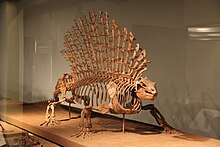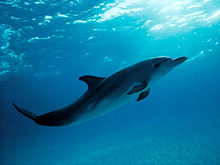
Back بليكوصوريات حقيقية Arabic بليكوصوريات حقيقيه ARZ Eupelicosaures Catalan Eupelycosauria German Eupelycosauria Spanish هوپلیکوسورها Persian Eupelycosauria Finnish Eupelycosauria French Eupelycosauria Galician 真盤竜亜目 Japanese
| Eupelycosauria Temporal range: Pennsylvanian–Recent, Possible Bashkirian records.
| |
|---|---|

| |
| Edaphosaurus pogonias skeleton mounted at the Field Museum | |

| |
| Atlantic spotted dolphin | |
| Scientific classification | |
| Domain: | Eukaryota |
| Kingdom: | Animalia |
| Phylum: | Chordata |
| Clade: | Synapsida |
| Clade: | Eupelycosauria Kemp, 1982 |
| Subgroups | |
| |
Eupelycosauria is a large clade of animals characterized by the unique shape of their skull, encompassing all mammals and their closest extinct relatives. They first appeared 308 million years ago during the Early Pennsylvanian epoch, with the fossils of Echinerpeton and perhaps an even earlier genus, Protoclepsydrops, representing just one of the many stages in the evolution of mammals,[3] in contrast to their earlier amniote ancestors.
- ^ a b Spindler, F., R. Wernburg, J. W. Schneider, L. Luthardt, V. Annacker, and R. Roßler. 2018. First arboreal ‘pelycosaurs’(Synapsida:Varanopidae) from the early Permian Chemnitz Fossil Lagerstatte, SE-Germany, with a review of varanopid phylogeny. Palaontologische Zeitschrift. doi: 10.1007/s12542-018-0405-9.
- ^ Neil Brocklehurst & Jörg Fröbisch (2018) A reexamination of Milosaurus mccordi, and the evolution of large body size in Carboniferous synapsids, Journal of Vertebrate Paleontology, 38:5, DOI: 10.1080/02724634.2018.1508026
- ^ Kemp. T.S., 1982, Mammal-like Reptiles and the Origin of Mammals. Academic Press, New York
© MMXXIII Rich X Search. We shall prevail. All rights reserved. Rich X Search